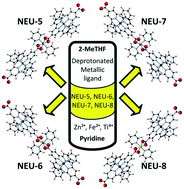Electro- and photoelectro-catalysts derived from bimetallic amorphous metal–organic frameworks†
Abstract
Fuel cells and electrochemical water splitting have attracted wide attention to address the demand of global energy and the depletion of fossil fuels. These promising and renewable energy alternatives implicate three pivotal reactions: oxygen reduction reaction (ORR), oxygen evolution reaction (OER) and hydrogen evolution reaction (HER). The design and synthesis of materials for efficient catalysis toward HER, OER, and ORR are of paramount importance. To address these aims, electro- and photoelectro-catalysts based on the controlled pyrolysis of bimetallic amorphous metal–organic frameworks (MOFs) are developed. The present study provides a general method for the design and synthesis of bimetallic amorphous MOFs by merging our liquid–liquid interface synthesis method and the metalloligand approach. As a proof of concept, NEU-5 (= [Zn(FeTpyCOOH)(PF6)2]n), NEU-6 (= [Zn(Ru(terpy*)2)(PF6)2]n), NEU-7 (= [Fe(Ru(terpy*)2)(PF6)2]n) and NEU-8 (= [Ti(Ru(terpy*)2)(PF6)2]n) are successfully synthesized, and subsequently pyrolyzed to prepare Fe2P@PNDCN, RuP@PNDCN, Fe3O4/RuO2@NEU-7 and Ru2O/TiN/TiO2@NEU-8, respectively. These electro- and photoelectro-catalysts exhibit excellent activity for ORR, OER and HER in both acidic and alkaline media.



 Please wait while we load your content...
Please wait while we load your content...